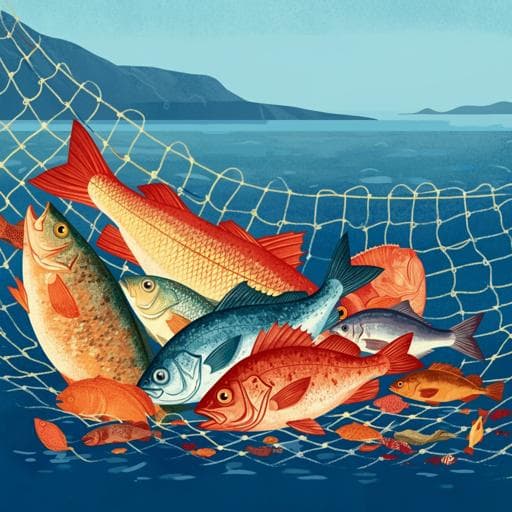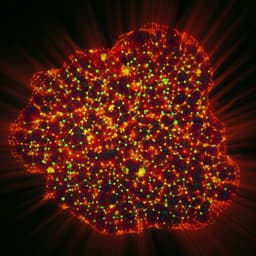
Food Science and Technology
Small-scale fisheries contribution to food and nutrition security—a case study from Norway
M. Kjellevold, G. A. Kuhnle, et al.
This study reveals how Norwegian small-scale fisheries can significantly enhance local food and nutrition security, potentially providing 5 million people with seafood servings rich in essential nutrients like vitamin B12 and DHA. Conducted by Marian Kjellevold and colleagues, the research emphasizes fisheries' role in meeting dietary needs and offers a sustainable alternative to supplements.
~3 min • Beginner • English
Introduction
Unhealthy diets and micronutrient deficiencies (e.g., vitamins D and B12, selenium, iodine) persist in Nordic countries. Aquatic foods contribute substantially to global protein intake and are rich in bioavailable micronutrients; in Norway, fish is a major source of vitamins D and B12, iodine, and marine n-3 fatty acids. Despite this, fish’s contribution to food and nutrition security (FNS) is under-recognized. Norway’s food self-sufficiency by energy was 45% in 2020 (with 80% of this from fish), and seafood exports are substantial. Small-scale fisheries (SSF) and large-scale fisheries (LSF) differ in fleet and operations; SSF are defined here as commercial vessels <15 m fishing within 12 nautical miles and fjords. The research question is to quantify Norwegian SSF catches, compare them to recommended dietary intakes, and assess their potential to contribute to national and local FNS, particularly under crisis scenarios when locally landed SSF catches are highly accessible.
Literature Review
The paper situates its inquiry within evidence that aquatic foods are important sources of nutrients and play a role in global diets, yet are underrepresented in FNS discourse. It references global and Nordic reports on nutrition-related diseases and deficiencies, the role of fish in nutrient provision, and the potential of dietary shifts toward aquatic foods to support climate mitigation. It also contextualizes the impact of COVID-19 on fisheries and seafood trade in various regions, highlighting SSF resilience in Norway. Prior work notes definitional variability of SSF and their potential economic efficiency. The Illuminating Hidden Harvests (IHH) project framework emphasizes multi-dimensional assessment of SSF contributions, including links to FNS and governance.
Methodology
Study context: Norwegian country case within the FAO/Duke/WorldFish Illuminating Hidden Harvests (IHH) project. The analysis connects SSF production data to nutrient composition to estimate potential contributions to FNS.
- Definitions: SSF defined as commercial vessels <15 m operating within 12 nautical miles and in fjords; LSF as vessels ≥15 m fishing inside/outside 12 nm. Recreational fisheries and inland fisheries are excluded; estimated untraded subsistence catches considered in overall context but the primary analysis focuses on SSF.
- Data sources: Fisheries landings and value from the Norwegian Directorate of Fisheries and the Institute of Marine Research; additional official sources. Nutrient composition from the open-access Seafood data database (IMR) with accredited laboratory analyses (ISO 17025:2005), including CRMs and uncertainty reporting; iodine data for cod, saithe, haddock from Nerhus et al. 2018. Missing nutrient values for certain species (e.g., haddock vitamin A, D, B12, DHA; edible crab vitamin A) were taken from the Norwegian Food Composition Table. Dietary intake data from NORKOST 3 (2010–2011, n=1787 adults, two 24-h recalls). NORKOST3 data were re-aggregated to species level and weighted for education to match population distribution.
- Conversions and calculations: Average SSF live-weight landings (2013–2017) per species converted to edible fillet using species-specific conversion factors (when unavailable, averages or edible part fractions were used). For the mixed “other fish” group, an average conversion factor and conservative nutrient assignment (lowest analytical value across five species for each nutrient) were applied. Total available amounts of nutrients (iodine, iron, zinc, calcium, vitamins A, D, B12, and DHA) from SSF were computed by multiplying fillet mass by species-specific nutrient contents. The target population was set at 5 million. Recommended intakes (RI) were from Nordic Nutrition Recommendations (NNR 2012) for women 18–60 years. The number of daily RI portions per person per year provided by SSF was calculated by dividing total nutrient availability by the RI, then normalizing by population size. Species-level weekly grams per person were similarly estimated by dividing total fillet mass by population and weeks. Handling of analytical limits: vitamin D values below LoQ except for herring and mackerel; analytical variability and sample sizes documented in supplements. Sustainability and management context for stocks obtained from ICES evaluations and Norwegian regulations.
Key Findings
- SSF catch scale and composition: Average total SSF landings (2013–2017) were ~233,392 tons live weight, accounting for 10.4% of Norway’s total catch (SSF+LSF). Average first-hand value was 2880 million NOK (17.7% of total value). Estimated total SSF fillet mass was ~86,500 tons. Cod dominates SSF (about 29.5% of total Norwegian cod catch), followed by herring, saithe, haddock, and mackerel. In 2017, 93.4% of SSF catch came from stocks evaluated as sustainable, 0.6% not sustainable, and 6% unevaluated.
- Potential weekly availability per person from SSF: Based on SSF fillet mass and a population of 5 million, weekly per-person availability is approximately: cod 173 g, herring 35 g, saithe 31 g, haddock 19 g, mackerel 31 g (total ≈288 g/week). Including “other fish” increases to ≈320 g/week; adding crustaceans/invertebrates increases to ≈360 g/week, aligning with Norwegian recommendations (300–450 g/week).
- Nutrient contributions: SSF catches could provide approximately 70% (iodine), 80% (DHA), and 96% (vitamin B12) of the annual RI per person for a population of 5 million. From Table 2, total annual daily RI portions per person available from SSF are: Vitamin A ≈4, Vitamin D ≈57, Vitamin B12 ≈352, Iron ≈3, Iodine ≈258, Zinc ≈14, DHA ≈294. Species contributions: cod is the largest contributor to iodine and DHA due to volume; herring provides the highest vitamin B12 content; saithe has high iodine concentration but lower total contribution due to lower volume; herring and mackerel are major DHA and vitamin D sources (only species with vitamin D above LoQ).
- Serving-level coverage: A 200 g portion of herring or mackerel meets daily RI for vitamin D, vitamin B12, and DHA; a 270 g portion of lean species (cod, saithe, haddock) meets daily iodine RI multiple times (3–14×). Cod liver (80 g) supplies ~56% of vitamin A RI and ~75% of vitamin D RI but contains dioxins and dl-PCBs.
- Food safety: Mean dl-PCBs in cod liver were 16.4 ng TEQ/kg (n=67, 2019; range 2.73–93.1; median 6.19). Benefit–risk assessments support recommended fish intake (300–450 g/week) across age groups despite contaminant concerns.
- Current consumption (NORKOST3): Among all adults (n=1787), mean seafood intake was 67 g/day (469 g/week) and median 30 g/day (210 g/week); 35% reported zero intake. Among consumers (n=1158), mean intake was 104 g/day (728 g/week) and median 83 g/day (581 g/week); over half of consumers exceeded the 300–450 g/week recommendation.
- Climate/sustainability: Average CO2 emissions footprint for Norwegian SSF was about 1/20 that of LSF (2013–2017).
Discussion
The study demonstrates that Norwegian SSF can substantially address national FNS by providing locally landed, year-round accessible seafood sufficient for 1–2 portions per person weekly for a population of 5 million. This level of availability translates into high coverage of key micronutrient requirements—particularly vitamin B12, iodine, and DHA—directly addressing micronutrient deficiencies identified in Norway. Cod’s dominant volume makes it pivotal for iodine and DHA contribution, while herring and mackerel provide concentrated DHA and vitamin D; saithe and haddock are strong iodine sources. Although fillets are not significant sources of vitamin A, iron, or zinc, inclusion of liver/roe and shellfish can bolster certain micronutrients, with attention to contaminants in liver. The findings support the view that shifting dietary patterns toward aquatic foods can improve nutritional quality and support climate mitigation, given SSF’s comparatively low carbon footprint. In crises, SSF’s localized operations enhance stability, availability, and utilization dimensions of food security; however, actual intake lags recommendations, highlighting gaps in access and agency. Product development (semi-industrial dishes) and coherent policies linking SSF production to consumers could increase consumption. Integrating fish as a micronutrient source into dietary guidelines may reduce reliance on supplementation/fortification. Overall, quantifying SSF’s nutrient provision provides evidence to inform policies that enhance FNS and sustainability.
Conclusion
Norwegian small-scale fisheries can supply approximately 1–2 seafood portions per person per week (about 360 g), covering an estimated 70–96% of annual RI for vitamin B12, iodine, and DHA for a population of 5 million. Cod, herring, saithe, haddock, and mackerel are the main contributors, with oily species providing high DHA and vitamin D and lean species supplying iodine. SSF catches are largely from sustainable stocks and have a markedly lower carbon footprint than LSF. These results highlight SSF’s strategic role in national FNS, resilience during crises, and climate goals. Policy implications include recognizing seafood as a nutrient-dense food in dietary guidelines, developing products to increase consumption, and aligning fisheries and nutrition policies to enhance access and agency. Future research should refine conversion factors for shellfish, expand nutrient analyses (e.g., haddock, shellfish), improve dietary assessment methods specific to seafood, and quantify consumption by fishery source (SSF vs. LSF vs. recreational).
Limitations
- Recreational and inland fisheries were excluded; subsistence and “taken home” estimates are approximate.
- No conversion factors for some invertebrates (shrimps, crabs), requiring assumptions (edible fractions) and averages for mixed species groups.
- Missing analytical nutrient data for certain species/nutrients (e.g., haddock vitamin A, D, B12, DHA; edible crab vitamin A); small sample sizes for some nutrients (n<10).
- High inter-individual variability in nutrient content within species (not fully captured by single food composition table values).
- Dietary intake data (NORKOST3) based on two 24-h recalls may not capture episodic seafood consumption or species-level diversity, leading to potential misestimation.
- By-products (liver, roe, trimmings) largely not included in primary availability estimates despite potential nutritional contributions.
- “Other fish” group required conservative nutrient assumptions (lowest values), possibly underestimating contributions.
Related Publications
Explore these studies to deepen your understanding of the subject.







